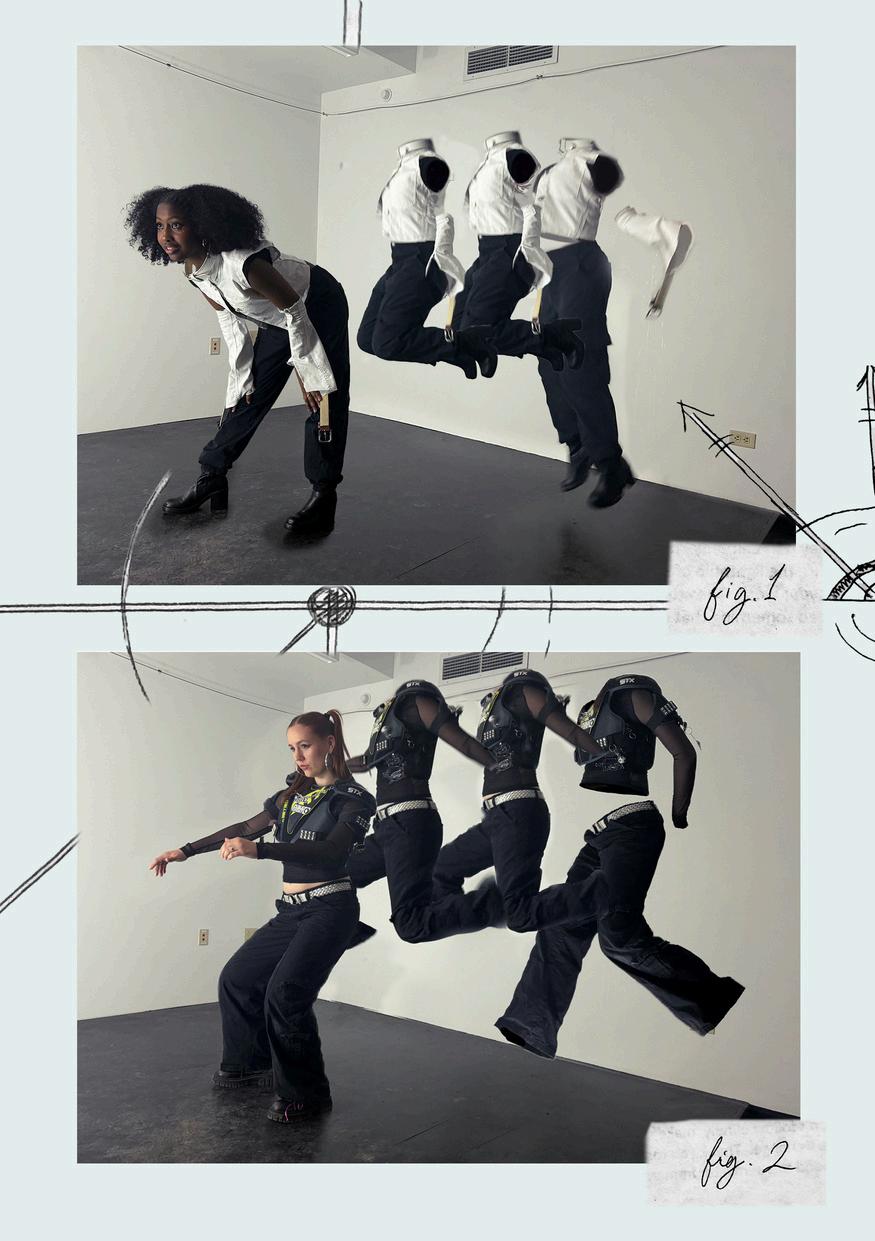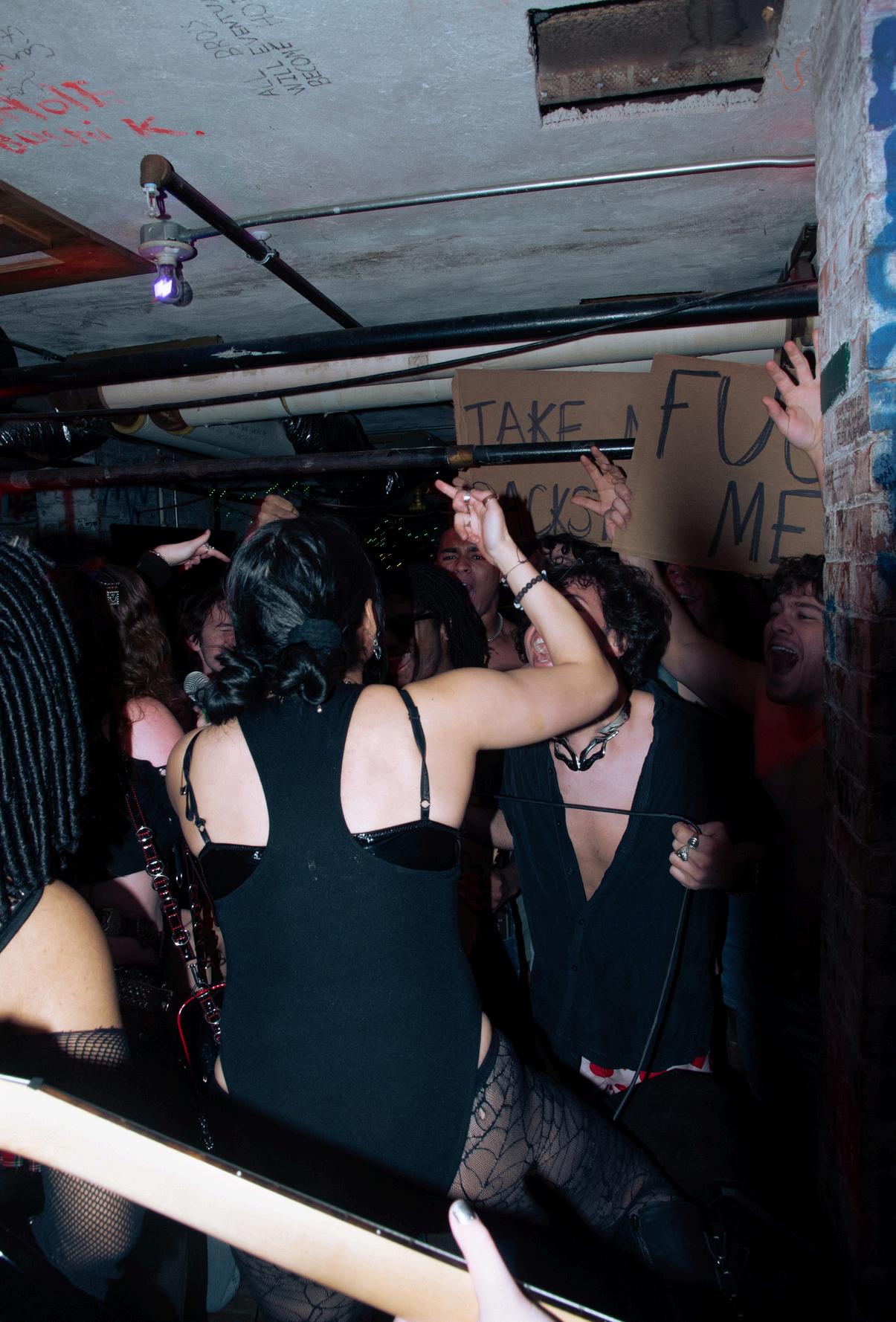
 Photographed by: Jasmin Wong
Photographed by: Jasmin Wong

T A B L E O F
Walk of Shame – Alex Ober
Stacked – Xandra Chen & Anika Kewalramani
Dystopian – Erick Buendia
Stellar – Cate Baldwin

Visual Manifestos: What the Fashion of the ‘Rogues’ of America’s Past Can Tell us About Our Present – Liam
Dorrien
Frontier – Mikail Haroon
C O N T E N T S

Teenage Sport – Sophie Clapacs Subverting Subversion–Adi Lurvey & Jingling Liu IRE–Tasmiah Akter Fashion or: How I Learned to Stop Worrying About and Loving Microtrends – Mia Foster Mossiah – Lena Weiman & Cecilia Dondorful-Amos Collect / Renew – Emma Steckline Unbound – Alexis Gerwe Fatal Femmes –Caroline Johnson

2

3







STACKED


 Lauren
Lauren
Berthoumieux Kofi Agyei-Yeboah
Jacob Carton
Ayer Richmond
Isa Miranda
Noor Valvani






Swaraj Rai Will Lee Emmett Levy
Ula Pranevicius
Xandra Chen
Anika Kewalramani
a video project by Anika Kewalramani and Xandra Chen












S

 Model: Stella Tannen
Director / Editor: Cate Baldwin
Photographer: Lilly Hoefflin
Model: Stella Tannen
Director / Editor: Cate Baldwin
Photographer: Lilly Hoefflin
T E
L L A R















frontier







 by mikail haroon
by mikail haroon
 creative direction by mikail haroon
photography by owen forbes
modeling by anika kewalramani, sita mcguire, and ricky liu
creative direction by mikail haroon
photography by owen forbes
modeling by anika kewalramani, sita mcguire, and ricky liu

















1 3
With Cleo Riley, Darius Nabers, and Reese Chahal


Teenage Sport
Sophie Clapacs
2



7

6


Subverting Subversion
By Adi Lurvey & Jingling Liu
“Rogue” fashion allows people to explore fashion as a way to subvert the established social order, expanding modes of expression through fashion. But how much can the people who benefit from the world's social order truly subvert it? Rogue fashion, for rich white people, often entails appropriating designs from other cultures or elevating working-class functional aesthetics, as a form of subversion. When rich white people take these styles and market them or try to bring them into their norm, they undermine any sense of subversion by making them highend.


Rogue fashion for the wealthy has a variety of different looks, but this past year the tabi shoe design took off considerably. Tabi shoes are a style of footwear with a split between the big toe and the rest of the toes, reminiscent of a hoove. Though these Tabi’s now go for upwards of $1000, their inspiration, Jika-tabi shoes, have been commonly used as footwear for construction workers, farmers, gardeners, and other laborers in Japan.




Tabis
Jaka-Tabi shoes allowed workers to be able to grip the ground while walking, allowing for more delicate and dexterous movements while simultaneously still being able to protect the foot. Jika-Tabi’s have been made out of a variety of different materials to individual worker’s needs; some are made purely out of rubber and are high kneed to best suit workers in rice fields and wet or muddy conditions, while others are made out of cloth and are more commonly used for exercise.
These shoes began their rise to fame in 1988 when Maison Martin Margiela, a luxury French designer, debuted the style in his first show. Margiela claims the Tabi “captures the avant-garde and insubordinate spirit of the Maison,” While the Maison claims the spirit of subversion, there is nothing inherently subversive about this Japanese shoe design other than its lack of prevalence in Western culture prior. By bringing Tabi’s into the mainstream as something that is both meant to be subversive and also inaccessible due to its status as high fashion, there is no doubt that Tabis have lost most of their original functionality. A style that initially started as working-class functional wear became appropriated by highend fashion designers, and has become neither functional nor accessible.







Denim
This trend extends beyond just Tabi’s and even to America’s quintessential pants—jeans. Jeans were initially adopted as the primary workwear of western cowboys, farmers, and railway workers in the US due to their unique durability and functional design. Denim eventually morphed into a symbol of youth rebellion movements, early punks would tear their jeans as a form of expressing their anger towards capitalism and corporate greed, starting the first designs of distressed denim. Ironically, corporations are selling jeans pre-distressed and pre-ripped, completely undermining their original meaning; these mass corporations benefit from the exploitation of the working class. As the roots of these trends get covered up by clothing brands, the trends morph into clothing corporations simply mimicking working-class appearances.
Brands like JNCOs, Diesel, True Religion, and even more commercial stores like Urban Outfitters all take inspiration from lower-class fashion trends and market to upper and middleclass suburban teens who have never had to experience the reality of being lower or workingclass. When upper or middleclass teens use jeans as a mode of rebellion without understanding these systemic concepts they appropriate lower class aesthetics they equivalent their general teen angst with the experience of classism.





Couture
The romanticization of poverty extends to the extreme in high fashion through mimicking the look of homelessness. Couture fashion designers for Dior have professed they take their inspiration from the homeless people whom they encounter on the street, as well as other companies like Yeezeys or N. Hollywood describes trying to mimic homelessness in their runway shows for NYFW. Rather than these designers making an effort to talk to the people they’re taking inspiration from, they simply observe their attire. The homeless aren’t trying to be fashionable. They’re trying to survive, and designers reduce the purpose of their clothing to an aesthetic choice. People who are homeless have to appear housed to attend things like job interviews or more professional settings, whereas people wearing the “homeless aesthetic” can put on and take off their clothes at will. These designers seem to display an incredible lack of empathy for the homeless and a lack of self-awareness about their social position. While it is possible to use “rogue” styles as a form of protest or rebellion, it is important to reflect on what is being rebelled against, and through what modes. Rogue fashion often entails rich people taking lower class aesthetics, ignoring the purpose behind the clothing, and reducing the realities of existing as lower class in a classist society boiling it down to something that can be romanticized on a Pinterest board.







Models:IshaBah,DikshyaKuikel,PriyanshuPokhrel Makeup:LaurenSchweitzer Producedby:VictoriaCornejo
Photographer:ErickBuendia Editors:ErickBuendia&TasmiahAkter



 by Mia Foster
by Mia Foster















COLLECT/RENEW COLLECT/RENEW
Creative Director: Emma Steckline
Photographer: Jenny Ongele
Makeup/Styling: Jazmin Alvarez
Produced by: Victoria Cornejo



























 Models: Hazel Allison-Way, Tanvi Navile, Felicity Guevara, Jo Harkless, Will Lee
Models: Hazel Allison-Way, Tanvi Navile, Felicity Guevara, Jo Harkless, Will Lee




FATAL FEMMES
THE MISANDRY

ROCK N ROLL ROGUES
REDEFINE THE GENRE
One girl group has risen to claim power over the punk rock scene. Hide your husbands and boyfriends, the MANEATERZ draw in hundreds of adoring groupies to each performance with a reputation that might be too X-rated even for us. The girls quickly reached the top of the rock charts with their raw talent and scandalous performance, and have drawn in quite the loyal fanbase. When asked about the constant droves of men flocking to their performances, one member stated “bring ’em on, themorethemerrier.”


roupies found TERZ concert er or not it’s an issue that this band of hot women are objectifying their mass amounts of devotee men. A groupie found waiting for the drummer outside of the bathroom states, “Personally, I love getting objectified”.

CREATIVE DIRECTOR: CAROLINE JOHNSON | PHOTOGRAPHER: MILES URBAN | PRODUCED BY:

Fray Magazine
VICTORIA CORNEJO





 PICTURED: HARMONY HOOGS, MAE COHEN, REY ALVAREZ, CECELIA DONDORFUL-AMOS, GINEVRA GILMORE, BETO VALDEZ, JAY WATSON, WILL LEE, NOLAN LEWIS, REX HECHTER
PICTURED: HARMONY HOOGS, MAE COHEN, REY ALVAREZ, CECELIA DONDORFUL-AMOS, GINEVRA GILMORE, BETO VALDEZ, JAY WATSON, WILL LEE, NOLAN LEWIS, REX HECHTER














Jasmin Wong
Erick Buendia
Kofi McF
Isha Bah
Dikshya
Meghan
Chloe G
Melanie
Alex Ob
Lucas B
Zachary
Aisyah N
Maya Ya
Priya
Mirem
Pazu
Eli M


Alexis Gerwe
Jack Siegel
Emma Steckline
Jenny Ongele
Tanvi Navile
Hazel Allison-Way
Felicity Guevara
Will Lee





Jo Harkless
Jazmin Alvarez
Victoria Cornejo
San De Min
Quinn Frankel

Ali Eckstein
Liam Dorrien
Caroline Johnson
Mae Cohen
Cecelia Dondorful-Amos

Ginevra Gilmore
Harmony Hoogs
Rey Alvarez
Beto Valdez
Ben Hsu
Nolan Lewis
Jay Watson
Ryan Villano
Warren Little
Yumiko Takahashi
Fia Jones
Mark Vinokur
Nathaniel Atkin
Samir Cerrato
Rex Hechter
Elijah Davis
Emmanuel Chery

Elias Owen
Jude Gravois

Anika Kewalramani
Xandra Chen
Lauren Berthoumieux
Kofi Agyei-Yeboah
Jacob Carton
Noor Valvani
Swaraj Rai
Emmett Levy
Ula Pranevicius
Ayer Richmond

Isa Miranda
Cleo Riley
Darius Nabers




Lena Weiman
Evan Hsu
Gabby Blanco
Jingling Liu
Adi Lurvey
Mikail Haroon
Owen Forbes
Ricky Liu
Sita McGuire
Alexis Gerwe
Carter Appleyard
Eva Gamboa
Tasmiah Akter
Isha Bah
Dikshya Kuikel

Lauren Schweitzer
Mia Foster
Reese Chahal
Sophie Clapacs
Cate Baldwin
C O L L A B O R A T O R S

















 Photographed by: Jasmin Wong
Photographed by: Jasmin Wong















 Lauren
Lauren



















 Model: Stella Tannen
Director / Editor: Cate Baldwin
Photographer: Lilly Hoefflin
Model: Stella Tannen
Director / Editor: Cate Baldwin
Photographer: Lilly Hoefflin






















 by mikail haroon
by mikail haroon
 creative direction by mikail haroon
photography by owen forbes
modeling by anika kewalramani, sita mcguire, and ricky liu
creative direction by mikail haroon
photography by owen forbes
modeling by anika kewalramani, sita mcguire, and ricky liu















































 by Mia Foster
by Mia Foster







































































